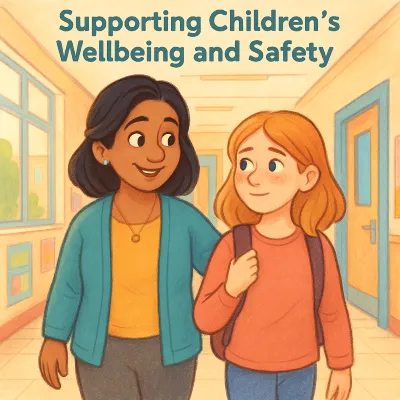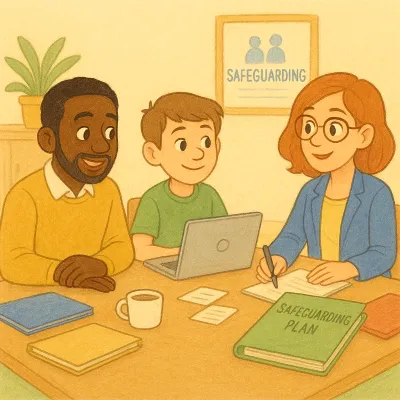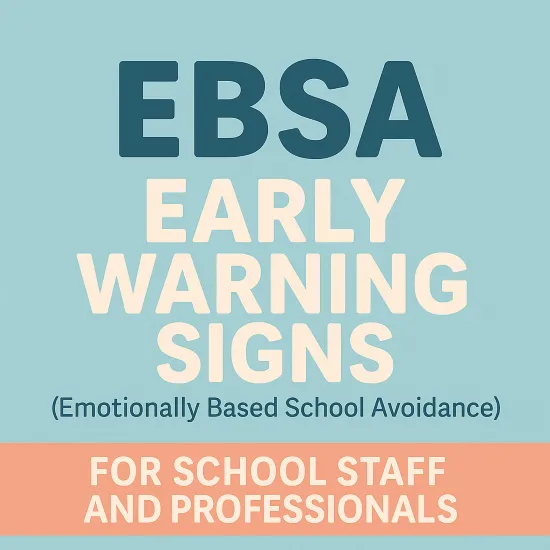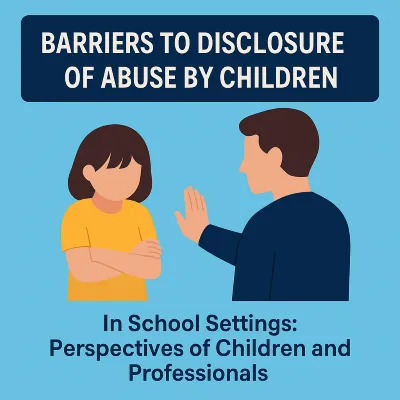What Is Interfamilial Child Sexual Abuse?
Sexual abuse perpetrated against children and young people constitutes a profound violation of their rights and well-being, with enduring consequences for individual development and societal health. The responsibility to safeguard children and provide comprehensive support to those who have experienced such trauma is a critical societal and professional imperative.
This article examines supporting children and young people affected by sexual abuse, with particular emphasis on the distinctive challenges of interfamilial sexual abuse. Occurring within the presumed sanctuary of the family, interfamilial abuse introduces complexities related to trust, betrayal, and systemic dysfunction that necessitate specialised understanding and intervention.
This paper will explore its conceptualisation, deep developmental ramifications, critical disclosure and initial response processes, evidence-based therapeutic interventions, and broader implications for professional practice and systemic reform. The aim is to contribute to a more informed, effective, and compassionate response to child and adolescent survivors.
Prevalence, Effects and Challenges of Interfamilial Child Sexual Abuse

Defining Interfamilial Sexual Abuse and Its Epidemiological Landscape: Scope and Challenges
Interfamilial sexual abuse refers to any sexual act involving a child and an older family member, or a person in familial trust and authority, where the child is used for the abuser's sexual gratification (Jerebic, 2019). This definition encompasses behaviours including forced sexual penetration, abusive sexual contact, and noncontact sexual abuse (Jerebic, 2019).
Accurately determining its prevalence is difficult due to underreporting, its hidden nature, and varied data collection. While population-level data indicate a significant minority of children experience sexual abuse, often by known perpetrators, specific figures for interfamilial abuse remain challenging to establish precisely (David et al., 2018).
The Unique Traumatic Milieu: Power Imbalances, Betrayal Trauma, and Systemic Secrecy in Familial Contexts
Interfamilial sexual abuse occurs within a unique traumatic milieu of profound power imbalances inherent in adult-child or older-younger sibling relationships. This disparity is exploited, creating an environment of coercion and fear.
The abuse signifies a deep betrayal of trust, as the perpetrator is someone the child should rely on for care (Hajal, 1999). This betrayal trauma can be particularly damaging to the child's developing self and their ability to form secure attachments. Furthermore, interfamilial abuse is often shrouded in systemic secrecy, where family dynamics, loyalty pressures, and fear of familial disintegration can silence the victim and protect the abuser, perpetuating harm (Ford, 2020).
Recognising the Signs and Indicators of Child Sexual Abuse
Interfamilial sexual abuse, as an adverse childhood experience (ACE), can precipitate significant neurobiological changes adversely affecting development and leading to substantial alterations in brain function (Guidetti et al., 2023).
Early childhood trauma, particularly when chronic and intrafamilial, can result in neuronal loss and hormonal dysregulation, influencing brain structures for emotion regulation, stress response, and cognitive processes like the anterior cingulate cortex, amygdala, and hippocampus (Guidetti et al., 2023). These neurobiological sequelae underpin cognitive impairments.
Traumatised children may exhibit deficits in sustained attention, impulsivity, and perform poorly on tasks evaluating abstract reasoning and executive functions, indicative of impaired prefrontal cortex functioning (Guidetti et al., 2023). Psycho-emotional consequences are severe.
Post-traumatic stress disorder (PTSD) is a frequent psychiatric outcome, characterised by intrusive thoughts, avoidance, and hyperarousal (Guidetti et al., 2023)(Jerebic, 2019). Survivors often experience pervasive fear, terror, and helplessness, alongside difficulties in emotional regulation, manifesting as affective instability, anger, and irritability (Guidetti et al., 2023).
Persistent shame is another profound emotional consequence contributing to PTSD symptoms (Feiring and Taska, 2005).
Developmental disruptions from interfamilial sexual abuse frequently manifest in a spectrum of behavioural issues, including externalising behaviours like aggression, oppositional-defiant attitudes, and risky behaviours, or internalising behaviours like depression, anxiety, and social withdrawal (Guidetti et al., 2023)(Kingston and Raghavan, 2009).
The betrayal inherent in abuse by a family member severely damages a child's capacity to trust and form secure attachments, leading to significant relational difficulties (Hajal, 1999). Survivors may struggle with interpersonal relationships, exhibiting insecure attachment, intimacy difficulties, or reliving abusive relational patterns, sometimes identifying with the aggressor defensively (Hajal, 1999).
Long-term impacts extend across life domains. Child sexual abuse (CSA) survivors are at increased risk for subsequent mental health disorders, substance abuse, poorer physical health, and difficulties in educational and occupational attainment (Alie-Poirier et al., 2020)(Hunter, Robison and Jason, 2012)(Etzel et al., 2020).
The experience can profoundly alter life course trajectories, underscoring the need for early, effective interventions (Ford, 2020).
How to Support a Child After Sexual Abuse Disclosure

Facilitating Disclosure: Recognising Indicators, Creating Safety, and Validating Survivor Narratives
Disclosure in interfamilial sexual abuse is often a protracted, complex process, not a single event (Alaggia, Collin-Vézina and Lateef, 2017). Recognising subtle behavioural, emotional, or physical indicators is essential, as many children may not disclose directly (DeVoe and Faller, 1999). Creating a safe, non-judgemental, supportive environment is paramount to encouraging a child to speak.
Professionals and caregivers must listen actively, validate the survivor's narrative, and reassure them they are believed and not to blame. The response to disclosure significantly influences subsequent help-seeking and recovery (Gayle, no date).
Perceived credibility can be influenced by the listener's trauma history and attitudes, requiring professional self-awareness (Cromer and Freyd, 2007). Men may face additional disclosure barriers due to societal norms (Elkins, Crawford and Briggs, 2017)(Hébert et al., 2009).
Trauma-Informed Responses to Interfamilial Sexual Abuse
An effective initial response to interfamilial sexual abuse disclosures must be trauma-informed and coordinated across multiple agencies. This involves prioritising the child's immediate safety and well-being while navigating intricate familial dynamics. Protocols should ensure clear communication and responsibility between child protection services, law enforcement, healthcare, and education (Ridings et al., 2019).
Addressing the complex family system is crucial, including supporting the non-abusing parent, who may also experience trauma, guilt, or disbelief, and assessing their capacity to protect the child (Serin, 2018)(Masilo and Davhana-Maselesele, 2016)(McCarthy et al., 2018).
The non-offending mother's support is often a critical protective factor, yet her own support needs must be recognised (Serin, 2020)(Smith et al., 2017). The goal is a network of safety and support, minimising further traumatisation.
Effective Therapies and Multi-Agency Responses to Child Sexual Abuse
Evidence-Based Therapies for Survivors of Child Sexual Abuse
Several evidence-based psychotherapeutic modalities support recovery from interfamilial sexual abuse. Trauma-Focused Cognitive Behavioural Therapy (TF-CBT) is widely recognised for addressing trauma-related symptoms, with adaptations for complex trauma (Hébert, Daignault and Blanchard-Dallaire, 2020)(Holtzhausen, Ross and Perry, 2016)(Susilowati and Dewi, 2019).
TF-CBT helps children process traumatic memories, develop coping skills, and manage distressing thoughts and feelings. Eye Movement Desensitization and Reprocessing (EMDR) is another effective approach for PTSD, facilitating traumatic memory processing (Guidetti et al., 2023). Studies suggest intensive trauma-focused treatments like EMDR and Prolonged Exposure can yield significant symptom reduction in CSA cases, even without extensive prior stabilisation (Wagenmans et al., 2018).
Beyond specific modalities, interventions should aim to build resilience, understood as a dynamic, cultivatable process (Elizabeth Michelle Defferary, Gregory Howcroft and Anne Stroud, 2018)(Clark, 2018). Approaches integrating affect, cognition, response, and helping survivors find meaning are critical for long-term healing (Walker-Williams and Fouché, 2018).
Establishing Holistic, Multi-Systemic Support: Integrating Family, Educational, and Community Resources
Recovery from interfamilial sexual abuse is enhanced by holistic, multi-systemic support beyond individual therapy. Integrating family, educational, and community resources creates a comprehensive care network.
Support from non-offending family members, particularly mothers, is a vital protective factor; interventions should strengthen these capacities while addressing caregiver distress (McCarthy et al., 2018)(McGillivray et al., 2018)(Bux, Cartwright and Collings, 2015). Schools can contribute by providing a safe, stable environment and being alert to distress.
Community-based interventions like support groups or recovery homes offer valuable peer support and reduce isolation (Hunter, Robison and Jason, 2012). Broader social support is consistently linked to better outcomes, buffering stress and promoting positive coping (Leslie, no date)(Gayle, no date).
Narrative approaches in couples or family therapy can facilitate sharing resilience stories and promote healing within relational systems affected by trauma (Francis Laughlin and Rusca, 2019). The aim is an ecological support system addressing the young survivor's multifaceted needs.
Prevention and Policy: Future Directions in Child Sexual Abuse Response

Strengthening Professional Competencies, Inter-Agency Collaboration, and Policy Frameworks
Effectively supporting children after interfamilial sexual abuse requires continuous strengthening of professional competencies. This includes specialised training for social workers, therapists, medical staff, educators, and legal professionals on trauma-informed care, interfamilial abuse dynamics, and culturally sensitive practices (Elkins, Crawford and Briggs, 2017).
Improved inter-agency collaboration is paramount for a seamless, coordinated response, reducing risks of survivors falling through service gaps or re-traumatisation (Ridings et al., 2019).
Policy frameworks must be robust, adequately resourced, and regularly reviewed to reflect best practices. This includes policies supporting early intervention, ensuring access to therapeutic services, and prioritising the child's voice and safety in all processes (Meinck et al., 2017).
Policies should also address non-offending caregivers' support needs, recognising their crucial role in recovery (Serin, 2018).
Advancing the Research Agenda: Addressing Knowledge Gaps and Improving Outcomes for Survivors
While significant progress has occurred, advancing the research agenda is critical to enhance understanding and improve outcomes for survivors of interfamilial sexual abuse. Key future investigation areas include longitudinal studies on long-term developmental trajectories and intergenerational trauma transmission (Etzel et al., 2020).
More research is needed on disclosure nuances across ages, genders, and cultures, and factors facilitating or hindering timely disclosure (Alaggia, Collin-Vézina and Lateef, 2017)(Delap, 2018).
Therapeutic intervention effectiveness for specific subpopulations, like very young children or those with comorbid conditions (e.g., ADHD), warrants further exploration (Guidetti et al., 2023).
Research ethics committees and researchers must navigate sensitive research complexities, ensuring participant well-being while collecting vital data, especially on non-recent abuse disclosures (Silverio et al., 2020). A focus on resilience-promoting factors and effective prevention strategies remains a research priority.
Conclusion: Promoting Healing and Resilience in Child Sexual Abuse Survivors
Synthesising Key Insights and Reaffirming the Imperative for Coordinated Action
This article underscored the profound, complex impact of interfamilial sexual abuse on children, detailing its unique traumatic milieu and severe developmental ramifications. The journey from disclosure to effective therapeutic intervention requires a sensitive, informed, multi-layered response.
Key insights reveal interfamilial abuse is characterised by betrayal trauma and systemic secrecy, leading to significant neurobiological, cognitive, psycho-emotional, and behavioural consequences altering life-course trajectories. Facilitating safe disclosure and providing trauma-informed initial responses are critical.
Evidence-based therapies, with holistic, multi-systemic support integrating family, educational, and community resources, are essential for recovery. The imperative for coordinated action among all stakeholders—professionals, policymakers, researchers, communities—is clear. Such collaboration is fundamental to ensuring young survivors receive comprehensive care and protection to heal.
Concluding Perspectives on Fostering Healing, Resilience, and Prevention
Ultimately, supporting children after interfamilial sexual abuse is a societal responsibility beyond immediate crisis intervention. It involves sustained commitment to environments where healing can occur and resilience actively cultivated (Elizabeth Michelle Defferary, Gregory Howcroft and Anne Stroud, 2018)(Gee et al., 2020).
This means recognising resilience not as an individual trait but a process supported by strong relational bonds and community networks (Clark, 2018). Efforts must also target robust prevention: public awareness campaigns challenging silence, education on healthy relationships and consent, and programs supporting vulnerable families.
By strengthening professional practice, reforming systems to be child-centred, and advancing research, we can improve support for current survivors and work towards preventing future abuse. The goal is enabling every child to grow up safe, nurtured, and with the opportunity to reach their full potential.


